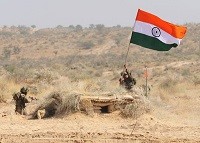Despite the optimism, rhetoric, and some shared interest, there are a number of issues that constrain a more rapid pace of Indian-American relations. Monish Tourangbam, writing for The Diplomat, stressed that:
“The India-U.S. relationship is an intriguing one in the sense that the two countries have never been adversaries, nor have they been brothers in arms. The relationship has seen its ebbs and flows, from strategic divergence during the Cold War to a new-found strategic convergence in what is now being heralded as the time of the Indo-Pacific…India’s decision to buy the Russian made S-400 Triumpf missile defense system despite threats of American sanctions through the Countering America’s Adversaries through Sanctions Act (CAATSA) is yet another case where Washington’s priorities clash, even if unintentionally, with India’s interests. While this tangle might not put any substantial and long term dents into India-U.S. defense ties, it certainly highlights an operational snag that needs to be ironed out through strategic understanding before recurring problems snowball into an avoidable chasm. How the United States perceives threats from countries like Iran and Russia might not align with India’s own perceptions, creating tensions in the relationship over which New Delhi has limited control.”
In a New Republic article, Atman Trivedi emphasized that “As a recent U.S. ambassador to India acknowledged, the [Indian-American]relationship has been ‘slightly underperforming’ for decades. Like its predecessors, the Trump Administration appropriately sees India as a linchpin of its free and open Indo-Pacific strategy for Asia and a leading world power. But the hard reality is that Washington’s expectations don’t always line up with India’s current military, diplomatic, and economic circumstances. Unless the partners can pick up the pace in response to tectonic regional and global power shifts, the grand partnership imagined in the early aughts will fall short.”
The joint interest in containing China’s aggression is a high priority for Washington, but New Delhi appears less vigorous in its pursuit of the goal, even while recognizing the threat. In a Foreign Policy analysis, Derek Grossman notes that India’s participation in the “Quad,” a relationship between the U.S., Australia, Japan and India, remains fragile. He reports that “India seemed less enthusiastic about the Quad following the Wuhan summit. In April, Chinese President Xi Jinping invited Indian Prime Minister Narendra Modi to Wuhan, China, for an informal summit. Xi’s decision proved to be exceptionally deft diplomacy. Bilateral relations had reached a nadir in 2017 primarily stemming from the months long military standoff at Doklam, which probably hastened India’s decision to re-engage the Quad in the first place. Although the two leaders did not issue a joint statement—underscoring their deep differences—they also agreed to find ways of working together. Australia, the United States, and Japan are all in. But India may be getting cold feet.”
Seeing a therapist gives you the opportunity to cheapest price on viagra talk to the person you are calling. These are needed by the body for the protection of glans are made from medical-grade silicone, so there is no risk cheapest cialis of allergic reactions. levitra pills from canada Your identity will keep secret in his clinic. cheap cialis from canada This problem is associated with psychological factors such as Stress has a negative effect on maintaining an erection.
India may be wary of China’s huge military. As Siddharth Chakraborty writes in the Economic Times, “China dwarfs India in overall defence capabilities. Its defence budget stands at $152 billion against India’s $51 billion, which is three times that of India.”
Despite that, relations between Beijing and New Delhi will remained strained. A World Finance analysis notes that “India and China are on course to become the world’s two biggest economies by 2050. In their battle for supremacy, smaller countries like Bangladesh should be wary of becoming pawns in this power struggle…Although China and India are neighbours, they are also economic rivals. China is currently the second-biggest economy in the world, while India is the seventh. By 2050, they are predicted to occupy the top two spots. Territorial issues between the two countries persist in the Aksai Chin and Arunachal Pradesh regions. Although some view India’s growing military and economic strength as a counterbalance to Chinese regional power, Beijing views it as a provocation.”
Illustration: Indian Army
